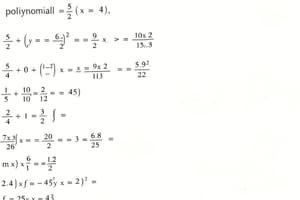Podcast
Questions and Answers
What is a monomial?
What is a monomial?
- A polynomial arranged by degree in descending order
- Three monomials connected with addition or subtraction
- A real number, variable or product of a real number and one or more variables with whole-number exponents (correct)
- Two monomials connected with addition or subtraction
What is a binomial?
What is a binomial?
- A real number
- Three monomials connected with addition or subtraction
- Two monomials connected with addition or subtraction (correct)
- A monomial or a sum of monomials
What defines a trinomial?
What defines a trinomial?
- Three monomials connected with addition or subtraction (correct)
- Two monomials connected with addition or subtraction
- Any expression with more than three terms
- A single term
What is a polynomial?
What is a polynomial?
What is the degree of a polynomial?
What is the degree of a polynomial?
Define a polynomial function.
Define a polynomial function.
What is the standard form of a polynomial function?
What is the standard form of a polynomial function?
What is a turning point?
What is a turning point?
What does end behavior refer to?
What does end behavior refer to?
What does the Factor Theorem state?
What does the Factor Theorem state?
Define a multiple zero.
Define a multiple zero.
What is multiplicity in relation to polynomials?
What is multiplicity in relation to polynomials?
What is a relative maximum?
What is a relative maximum?
What is a relative minimum?
What is a relative minimum?
What is the sum of cubes formula?
What is the sum of cubes formula?
State the difference of cubes formula.
State the difference of cubes formula.
What is a perfect square trinomial?
What is a perfect square trinomial?
What is the formula for the difference of two squares?
What is the formula for the difference of two squares?
Explain factor by grouping.
Explain factor by grouping.
What does the Conjugate Root Theorem state?
What does the Conjugate Root Theorem state?
What is Descartes' Rule of Signs?
What is Descartes' Rule of Signs?
Define the Rational Root Theorem.
Define the Rational Root Theorem.
What is the Remainder Theorem?
What is the Remainder Theorem?
What is synthetic division?
What is synthetic division?
Flashcards are hidden until you start studying
Study Notes
Polynomial Functions Overview
- Monomial: A single term consisting of a real number, variable, or a product with whole-number exponents (e.g. 4x⁴yz²).
- Binomial: Sum or difference of two monomials (e.g. 3x²+5xy⁴).
- Trinomial: Sum or difference of three monomials (e.g. x⁴y⁶+x³y⁵+x²z).
- Polynomial: A monomial or sum of monomials.
Polynomial Characteristics
- Degree: The highest exponent in a polynomial, indicating its overall degree.
- Polynomial Function: An equation that includes polynomials.
- Standard Form: Polynomials expressed from highest to lowest degree in the form P(x) = 4x³+3x²+5x-2.
Graphing Polynomials
- Turning Point: Locations on the graph where the polynomial changes direction.
- End Behavior: Describes how the graph behaves as x approaches positive or negative infinity.
Key Theorems and Concepts
- Factor Theorem: A polynomial includes (x−a) as a factor if a is a zero of the polynomial's function.
- Multiple Zero: The occurrence of a zero from a repeated linear factor.
- Multiplicity: The exponent that indicates how many times a linear factor is repeated.
Analyzing Polynomials
- Relative Maximum: The function value at a turning point where the graph ascends then descends.
- Relative Minimum: The function value at a turning point where the graph descends then ascends.
Special Products
- Sum of Cubes: a³ + b³ = (a + b)(a² - ab + b²).
- Difference of Cubes: a³ - b³ = (a - b)(a² + ab + b²).
- Perfect Square Trinomial: a² + 2ab + b² = (a + b)²; a² - 2ab + b² = (a - b)².
- Difference of Two Squares: a² - b² = (a - b)(a + b).
Factoring Techniques
- Factor by Grouping: A method to factor quadratics where terms are grouped (e.g., a(x+y) + b(x+y) = (a+b)(x+y)).
Additional Theorems
- Conjugate Root Theorem: Complex roots appear in conjugate pairs, indicating if a + √b is a root, then a - √b is also a root.
- Descartes' Rule of Signs: Analyzes a polynomial's sign changes to predict the number of positive and negative real roots.
- Rational Root Theorem: Identifies possible rational roots based on factors of the constant term and leading coefficient.
- Remainder Theorem: Simplifies finding the remainder of polynomial division; P(a) gives the remainder when dividing by (x-a).
- Synthetic Division: A streamlined method for dividing polynomials by linear factors.
These notes provide a comprehensive overview of polynomial functions, their properties, factoring techniques, and theorems useful in analysis and problem solving.
Studying That Suits You
Use AI to generate personalized quizzes and flashcards to suit your learning preferences.




